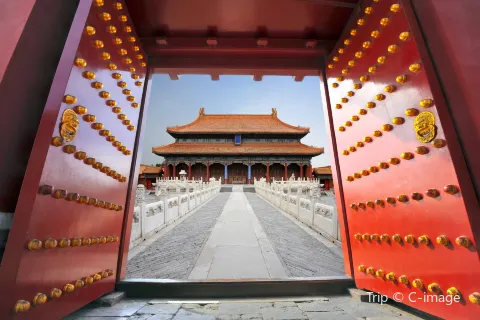https://https://au.trip.com/toplist/tripbest/recommend/hejian/best-things-to-do/10072522900000



Best Things to Do

Popular Best Things to Do Near Hejian [2025]



Show All Photos

The Palace Museum
4.8
/5
181157 reviews
10
From AU$ 8.61

Based on 14,211 reviews
Tian'anmen Square and Wangfujing Area | >100 km from downtown
Phone 4009501925
Address: No. 4, Jingshanqian Street, Dongcheng District, Beijing
Recommended sightseeing time: 0.5-1 day
Highlights: World Heritage Site | World's largest wooden palace complex
Verified User Reviews



The scarlet walls, the tiles of yellow glazed, discharged a square city. Tourists crowded next to each other, under the guidance of the guide flag, the tide surged through the threshold. The flash of the camera was bursting from time to time, and it became more and more gloomy and gloomy of the old temples. I walked past Taihe Temple, and saw a few students in school uniforms, busy on the stone steps, "selfie", laughing haha. The dragon chair in the hall, the gold paint peeled off most of the center, still sitting in the center, staring emptyly at the moving head. A hundred years ago, here kneeling full of shuddering officials; Now, tourists are just a glance away, and they rush to the next attraction. Outside the palace wall, the vendors selling "Royal Food" are faintly heard. A crow stops at the horns, and looks at all this coldly. Suddenly, its wings fly away, and a black crack in the sky.
During the Dragon Boat Festival holiday, I took my mother to Beijing to play. Fortunately, I asked Xiucai to explain. Xiucai said that the explanation of Li Dao was very wonderful. My mother was very happy and helped him take a lot of beautiful photos. Very intimate, I will definitely choose Xiucai to say next time I come to Beijing!



Show All Photos

Universal Beijing Resort
4.6
/5
41028 reviews
10
From AU$ 98.10

Based on 61 reviews
Universal Beijing Resort and Sorrounding | >100 km from downtown
Phone 4000 688 688
Address: Universal Beijing Resort, Tongzhou District, Beijing
Recommended sightseeing time: 1-2 days
Highlights: World's 5th Universal Studios theme park | Scenic spots with Chinese elements
Verified User Reviews



The amusement park near my home is not big, but it is the fifth largest in the world and the only one in China. Most importantly, it only takes an hour to get there by train. How fun! I have been there five times. I love Jurassic Park the most.
I still go there at least once a year. It is actually more convenient to take the subway, but I am used to driving. There are still many people queuing to enter. The cultural and creative store on City Avenue updates cultural and creative products from time to time. I like Minions things very much. There is also a huge PopMart store.



Show All Photos

Badaling Great Wall
4.7
/5
50648 reviews
10
From AU$ 8.63

Based on 11,086 reviews
Badaling Great Wall/Badaling Wildlife Park | >100 km from downtown
Address: Exit 58 of G6 Beijing-Lhasa Expressway, Yanqing District, Beijing
Recommended sightseeing time: 3-4 hours
Highlights: World Heritage Site | The best preserved Great Wall
Verified User Reviews



The Badaling Great Wall is located at the north exit of the ancient road of Jundushanguangou in Yanqing District, Beijing. The area of the tour area is 1.19 million square meters. It is an important part of the Great Wall of ancient China's great defense project and is a pass of the Great Wall of Ming Dynasty. The Badaling Great Wall is an important outpost of Juyongguan, which in ancient times said "Juyong's risk is not at the Guan but in Badaling".
Very good, but the weather was bad and foggy when we went, but it was still worth it. At first, I bought a one-way cable car ticket, but it was useless, because I found that I didn’t go far.
No.
4


Show All Photos

National Museum of China
4.8
/5
9264 reviews
9.0

Based on 958 reviews
Tian'anmen Square and Wangfujing Area | >100 km from downtown
Phone 010-65116400
Address: East side of Tiananmen Square, No. 16 Dongchang'an Street, Dongcheng District, Beijing
Recommended sightseeing time: 0.5-1 day
Highlights: Over 1.43 million items | National treasures | Simuwu Dafang Ding
Verified User Reviews



The National Museum of China has made an appointment several times before, and it takes a week to make an appointment in advance. On weekdays, there are still a lot of people, very, very many. Be sure to avoid holidays. Levels of security check, bring your ID card. Guoboli is all national treasure. The negative layer is the most awesome, it is recommended to visit the negative layer carefully. The four floors on the ground, if you count the negative one, there are five floors in total. Basically, you can go shopping for a day inside.
Visited the National Museum's heavy exhibition "Beauty of Multi-element - Ancient Greek Art and Life Exhibition", was deeply shocked by the ancient Greek aesthetics, the cloth exhibition closely followed the theme, with beauty as the main line, to show us the ancient Greek human body, makeup and daily three aspects. Let us appreciate the persistence and creativity of this ancient civilization of the country to the beauty, the exhibition hall is more than 2,000 square meters, exhibiting bronze, gold jewelry, glass products, murals, sculptures and pottery and other 279 precious cultural relics, many cultural relics are the first time to be displayed outside Greece. The exhibition runs until June 5, taking advantage of the final rush.
No.
5


Show All Photos

Prince Kung's Mansion
4.7
/5
27115 reviews
8.9
From AU$ 8.63

Based on 429 reviews
Houhai Area | >100 km from downtown
Phone 010-83288149
Address: No.14, Liuyin Street, Xicheng District, Beijing
Recommended sightseeing time: 2-4 hours
Highlights: Over 30 different architectural complexes | Fu Jen Catholic University
Verified User Reviews



Located next to Shichahai, there are many traditional Beijing buildings and attractions around it, as well as authentic snacks. After visiting the attractions, you can feel the historical atmosphere of old Beijing nearby. The interior decoration and carving patterns of the building are exquisite. There are more than 20 kinds of assorted carvings such as bat-shaped and scroll-shaped on the windows of the back building. The bat patterns in the garden are all over the paintings and window edges, reflecting the "Fu culture". Many of them are not allowed to be visited, which is a pity
It's more fun to visit than the Forbidden City (mainly because the attractions are so crowded and not worth showing)
The cultural and creative products are super nice and thoughtful!
It's just that there are a lot of people on May Day, and it was crowded to see the golden nanmu tree...
And the longevity stele, it's estimated that it will take two hours to queue up, so I gave up
No.
6


Show All Photos

Temple of Heaven
4.7
/5
18587 reviews
8.8
From AU$ 57.78
Qianmen, The Temple Of Heaven and Chongwenmen | >100 km from downtown
Phone 13716920363
Address: No.1, Tiantan Road, Dongcheng District, Beijing
Recommended sightseeing time: 2-4 hours
Highlights: World Heritage Site | Ming & Qing emperors prayed for blessings altar
Verified User Reviews



Comprehensive review of the Temple of Heaven Park
I. Historical and cultural value
As a place for emperors of the Ming and Qing dynasties to offer sacrifices to heaven and pray for good harvests, the Temple of Heaven is a concentrated embodiment of the ancient Chinese idea of "respecting heaven and following ancestors" and carries the historical memory of more than 2,000 years of sacrificial culture. Its architectural complex was built in the 18th year of Yongle in the Ming Dynasty (1420). After many repairs in the Ming and Qing Dynasties, the existing four architectural complexes, namely the Altar of Prayer for Good Harvests, the Circular Mound Altar, the Palace of Abstinence, and the Divine Music Office, are the largest and most complete ancient architectural complexes for offering sacrifices to heaven in China. In 1998, it was listed in the World Cultural Heritage List by UNESCO and became an important symbol of Eastern civilization.
II. Architectural and design features
1. Integration of cosmology and ritual system
The design of the Temple of Heaven strictly follows the philosophical concept of "round heaven and square earth". The Hall of Prayer for Good Harvests in the north of the inner altar is a circular three-layered eaves with a pointed roof, symbolizing "round heaven"; the Circular Mound Altar in the south is a square base, symbolizing "square earth". The Danbi Bridge connects the two altars, forming a north-south central axis, reflecting the ancient spatial order of "left heaven and right earth".
◦ Hall of Prayer for Good Harvests: The 28 golden nanmu pillars correspond to the number of stars (the 4 pillars in the inner circle symbolize the four seasons, the 12 pillars in the middle circle symbolize the twelve months, and the 12 pillars in the outer circle symbolize the twelve hours). Its blue glazed tile roof and painted art show the peak of ancient architectural skills.
◦ Echo Wall and Circular Mound: The acoustic phenomenon of the Echo Wall and the "nine steps and nine levels" numerical design of the Circular Mound Altar reflect the ancient people's profound understanding of the laws of nature.
2. Zoning of sacrificial functions
The Zhai Palace is where the emperor fasts before the sacrifice. The building uses green glazed tiles, which forms a hierarchical difference with the sacrificial buildings and strengthens the idea of "respecting heaven"; the Shenyue Office is a place for ritual and music rehearsal, showing the integrity of the sacrificial culture.
3. Gardens and ecological landscapes
• Ancient tree community: There are more than 3,500 century-old pine, cypress and locust trees preserved in the park, and the oldest tree is hundreds of years old, forming a solemn atmosphere of "green and blue surrounding the sky". Ancient trees are marked with red cards (over 300 years old) and green cards (100-300 years old), which have both scientific and cultural value.
• Greening layout: The green coverage rate of 1.63 million square meters reaches 60%, and the lawns and ancient buildings complement each other, creating a "forest and quiet" temple garden artistic conception.
IV. Tourist experience and controversy
1. Highlights
◦ Must-visit attractions: The grandeur of the Hall of Prayer for Good Harvests, the acoustic wonders of the Echo Wall, and the echo of the "Heavenly Heart Stone" of the Circular Mound attract a large number of tourists.
◦ Cultural activities: Regular activities such as plant science popularization, ancient tree protection, and wild bird observation are held to deepen the modern dissemination of cultural heritage.
◦ Convenient facilities: Wheelchair rental and stroller services are provided, and the main road is wide and suitable for family tours; cultural and creative stores are popular, combining fun and cultural dissemination.
2. Pain points
◦ Crowded flow: There are dense tourists on holidays and weekends, and popular attractions such as the Hall of Prayer for Good Harvests need to queue up, which affects the experience.
◦ Ticket price: 34 yuan for peak season combined ticket (including major attractions),
The Temple of Heaven is not only Beijing's "urban green lung", but also a spiritual landmark of Chinese civilization. How to protect this cultural heritage in the process of modernization will be the core proposition of its future development.
The Temple of Heaven Park has recently been particularly firey, especially during holidays, people are endless, shoulder-to-shoulder, the Temple of Heaven is the standard in China. The Temple of Heaven in Beijing is popular in front of the Temple of Heaven, which shows that the Temple of Heaven Park is far-reaching. In fact, when you go to the Temple of Heaven Park, you also need to see the ancient trees. The ancient cypress is the most gathering place there. Only here can you talk to the ancient trees for hundreds of years, and experience the ancient civilization and dialogue. It is recommended to go to the Temple of Heaven for a while, and experience the charm of the ancient city of Beijing.
No.
7


Show All Photos

Summer Palace
4.7
/5
47965 reviews
8.8
From AU$ 62.09

Based on 15,082 reviews
Zhongguancun Area | >100 km from downtown
Address: No. 19, Gongmeng Road, Haidian District, Beijing
Recommended sightseeing time: 0.5-1 day
Highlights: World Cultural Heritage | The World's Longest Promenade
Verified User Reviews



Stepping into the Summer Palace, the first thing that comes into view is the blue waves of Kunming Lake. The lake is shining in the sun, like a huge mirror, reflecting the surrounding mountains and pavilions. You can rent a boat and row leisurely on the lake, feel the breeze, let the cool water vapor disperse the summer heat. The 17-hole bridge in the distance is like a long rainbow lying wave, connecting the South Lake Island and the lake shore. The stone lions on the bridge are in different shapes, as if telling an ancient story.
You can choose to take a boat tour of the Summer Palace. Now many places in the Summer Palace have opened 11 routes, covering popular attractions and main tour routes: Paiyunmen Huanhu Lake 40 yuan/person Changguantang - Nanhu Island 40 yuan/person Shiqi - Nanhu Island 40 yuan/person Nanhu Island - Jingming Building 30 yuan/person Tongniu - Shi Zhangting 40 yuan/person Nanhu Island - Yudai Bridge 30 yuan/person Nanruyimen - Nanhu Island 30 yuan/person Suzhou Street - Suyunxuan 30 yuan/person Nanruyimen - 40 yuan/person Suyunxuan - 17-hole bridge 40 yuan/person Zaojiantang Water View Lotus (summer) 40 yuan/person
No.
8


Show All Photos

Baotu Spring
4.6
/5
43773 reviews
8.7
From AU$ 8.63

Based on 888 reviews
Quancheng Plaza Commercial Area | >100 km from downtown
Phone 0531-86920680
Address: No. 1 Baotu Spring South Road, Lixia District, Jinan City
Recommended sightseeing time: 1-2 hours
Verified User Reviews



I went there during the Dragon Boat Festival,
because it is the representative of Jinan.
I was shocked by the crowds,
but the scenery is still good.
In addition to the many springs,
there are also large bamboo forests, rockery, etc.
Li Qingzhao Pavilion is also worth slowly appreciating.
The 40-yuan ticket price is a bit expensive,
the management is very average,
and the scenic area map is not very clear.
Don't come during holidays unless necessary.
Maybe because there are few rainy days in Jinan recently, the spring is relatively small, but the overall environment inside is still quite good, surrounded by springs and green trees, and many exhibitions look pretty good. Overall it's okay.
No.
9


Show All Photos

Mount Taishan
4.7
/5
25116 reviews
8.6
From %1$s

Based on 1,699 reviews
Jade Emperor Peak/Mount Tai Peak Area | >100 km from downtown
Phone 0538-96008888
Address: Taishan District, Tai'an City
Recommended sightseeing time: 1-2 days
Verified User Reviews



The first time I felt the mountains in the north, it was indeed different. Unlike the south, the mountains were mostly pine trees, Jinshi Cangsong, and there was no style of Zhumao trails in the south. Red Gate entered the mountain and took the classic hiking route. It started at 5:30 in the morning. On the road, I met many tourists who were optimistic about the sunrise and went down the mountain. And to the top of the mountain, still feel the cold strong wind, staying on the top of the mountain for one night is also quite hard for a glimpse of the beauty.
Taishan is worthy of the first of the five mountains. Although the process of climbing is relatively hard, I also insisted on climbing. It will really be the top of the Lingjie. The scenery is really great. I will come again if I have a chance.
No.
10


Show All Photos

MuTianYu Great Wall
4.8
/5
24715 reviews
8.4
From AU$ 9.71

Based on 24,416 reviews
Mutianyu Great Wall/Xiangshuihu Great Wall area | >100 km from downtown
Phone 010-61626022
Address: Mutianyu Village, Bohai Town, Huairou District, Beijing
Recommended sightseeing time: 3-5 hours
Highlights: Overlooking the Great Wall (Cable car) | Shoguan Terrace (Landmark)
Verified User Reviews



If you get a chance make sure you go…. One in a thousand best experiences.
I came to Beijing for four years. I came to Mutianyu Great Wall for the first time and climbed with my family. The scenery is very beautiful, relatively good to climb, quite a lot of foreign friends, the overall is quite good, the whole process of climbing up and climbing down ~ The only bad thing is that the traffic is not very convenient, you have to drive over ~
1
2
3
4
5
Payment Methods
Our Partners
Copyright © 2025 Trip.com Travel Singapore Pte. Ltd. All rights reserved
Site Operator: Trip.com Travel Singapore Pte. Ltd.
Site Operator: Trip.com Travel Singapore Pte. Ltd.




